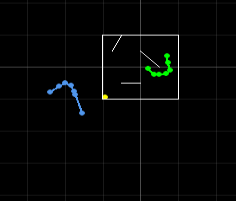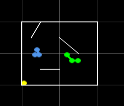Implement the Bayes filter in Simulation
def compute_control(cur_pose, prev_pose):
""" Given the current and previous odometry poses, this function extracts
the control information based on the odometry motion model.
Args:
cur_pose ([Pose]): Current Pose
prev_pose ([Pose]): Previous Pose
Returns:
[delta_rot_1]: Rotation 1 (degrees)
[delta_trans]: Translation (meters)
[delta_rot_2]: Rotation 2 (degrees)
"""
#getting vars from input
distX = cur_pose[0] - prev_pose[0];
distY = cur_pose[1] - prev_pose[1];
#calculating results based on lecture 11
delta_rot_1 = loc.mapper.normalize_angle((math.degrees(math.atan2(distY, distX))) - prev_pose[2]);
return delta_rot_1, np.sqrt((distX*distX)+(distY*distY)), loc.mapper.normalize_angle((cur_pose[2]-prev_pose[2]-delta_rot_1))
return loc.gaussian(computed_control[0], u[0], loc.odom_trans_sigma)*loc.gaussian(computed_control[1], u[1], loc.odom_rot_sigma)*loc.gaussian(computed_control[2], u[2], loc.odom_rot_sigma)
computed_control = compute_control(cur_odom, prev_odom)
for xpast in range(mapper.MAX_CELLS_X):
for ypast in range(mapper.MAX_CELLS_Y):
for apast in range(mapper.MAX_CELLS_A):
if (loc.bel[(xpast, ypast, apast)] > .00001):
for xcur in range(mapper.MAX_CELLS_X):
for ycur in range(mapper.MAX_CELLS_Y):
for acur in range(mapper.MAX_CELLS_A):
prob_state = odom_motion_model(mapper.from_map(xcur, ycur, acur), mapper.from_map(xpast, ypast, apast), computed_control)
loc.bel_bar[(xcur, ycur, acur)] += loc.bel[(xpast, ypast, apast)]*prob_state
def sensor_model(obs, pos):
""" This is the equivalent of p(z|x).
Args:
obs ([ndarray]): A 1D array consisting of the measurements made in rotation loop
pos : x, y, a tuple
Returns:
[ndarray]: Returns a 1D array of size 18 (=loc.OBS_PER_CELL) with the likelihood of each individual measurements
"""
prob_array = [0]*mapper.OBS_PER_CELL;
element = mapper.obs_views[(pos[0], pos[1], pos[2])]
for i in range(mapper.OBS_PER_CELL):
prob_array[i] = loc.gaussian(obs[i]-element[i], 0, loc.sensor_sigma);
return prob_array
def update_step():
""" Update step of the Bayes Filter.
Update the probabilities in loc.bel based on loc.bel_bar and the sensor model.
"""
for xpos in range(mapper.MAX_CELLS_X):
for ypos in range(mapper.MAX_CELLS_Y):
for apos in range(mapper.MAX_CELLS_A):
cur_pose = np.array([xpos, ypos, apos])
prob_sense = 1;
sense_model = sensor_model(loc.obs_range_data, cur_pose)
for k in range(mapper.OBS_PER_CELL):
prob_sense *= sense_model[k]
loc.bel[(xpos, ypos, apos)] = prob_sense*loc.bel_bar[(xpos, ypos, apos)];
loc.bel = loc.bel/np.sum(loc.bel)


